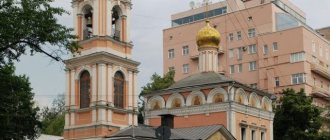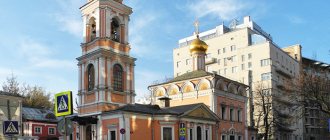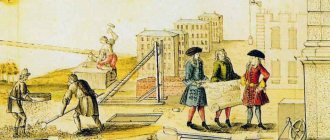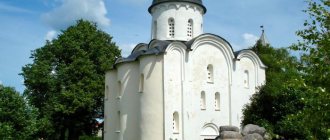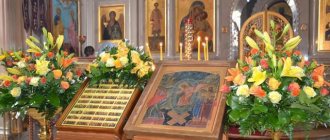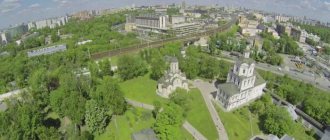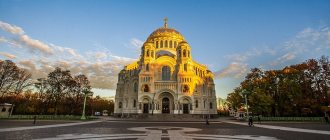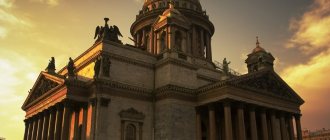The life of royalty is always shrouded in secrets and legends. They are credited with affairs with prominent figures of the era, illegitimate children, secret and overt murders. According to one of these legends, the daughter of Peter I, Elizabeth, in her old age, decided to repent of her sins and go to a monastery, devoting her life to serving God. But she did not want to live in one of those monasteries that already existed. By order of the Empress, a site was chosen on the left bank of the Neva. The village of Spasskoye, which was under the control of Veliky Novgorod, was previously located here.
Choosing a site for construction
The fate of the village is quite sad. The Swedes, who hated everything Russian, razed it to the ground. Peter I, having founded St. Petersburg, did not waste time and money on restoring the village and the temple of the same name. The Smolny Dvor was built on this site, where resin was boiled. The country needed a fleet; Peter was impatient to conquer the Baltic and Black Sea. In close proximity to the resin factory there was the Summer Palace, where the empress spent her childhood. In 1774, a fire completely destroyed part of the estate. Despite everything, Elizabeth does not give the order for restoration, but decides to build the Novodevichy Monastery and a new temple on the site of the fire. Here she plans to end her earthly journey, handing over the reins to her nephew.
Initial plans
The monastery was planned in an unusual way for that time. Only girls of noble birth were accepted as novices. Servants had to do the cultivation of the garden, cooking, and cleaning the yard. For each of the one hundred and twenty girls, separate apartments with living rooms and rooms for receiving guests were built. A separate house with everything necessary was allocated for Elizabeth. Elizabeth did not continue the tradition established by Peter I and decided to return to the origins of the construction of Orthodox churches. The Assumption Cathedral in Moscow was taken as a basis, and five chapters were planned for the main church. To implement the grandiose plan and construction, Francesco Bartolomeo Rastrelli, who by that time had gained fame in Europe, was invited to Russia in 1748. The architect presented his design for the Smolny Cathedral to the empress. The entire complex was shaped like a cross. In the center is a temple that can accommodate up to 6,000 people who want to pray. The sides of the cross were residential buildings for novices.
Ghost Temple
For five whole years the cathedral stood with an unfinished chapel and without domes. He looked like a ghost. There was a legend among the people that one of the workers committed suicide inside the temple, and therefore services could not be held in it for a hundred years.
It’s hard to say whether this is true or not, but Smolny really hasn’t been completed and consecrated yet. When Catherine II came to power, she removed Elizabeth Petrovna’s favorite from business and entrusted the construction to the architect Yuri Felten. The Empress settled “noble maidens” in the building of the Smolny Monastery, who were immediately dubbed “Smolyans”. At the beginning of the 19th century, they moved to the Smolny Institute, which was built nearby, and the Widow's House was located in the failed monastery.
Smolny Monastery, I. Aivazovsky, 1849 Source: wikipedia.org
Cathedral architecture
For the 18th century, the project was grandiose. The helmet-shaped dome with a bulbous head, surrounded by small belfries, rose to 92 meters. It was decided to move away from the classical canons in the design of the Smolny Cathedral. The white walls gave way to paintings and gilding, decorated with lucarnes and arched pediments. Blue was chosen as the main color, gray for the domes. The small belfries surrounding the main dome were built in two tiers and ended with onion-shaped domes. The corners of the cruciform complex formed house churches. At the same time, the bell tower was supposed to rise above the central dome - 140 meters. There was no taller building in Europe at that time. This plan of the architect is not destined to come true.
Revolutionary Smolny
The Institute for Noble Maidens was located in the Smolny Monastery until August 1917. From this moment on, the Council of Workers' and Soldiers' Deputies meets in the building.
On October 25, 1917, according to the old style, the Second Congress of Soviets is held in Smolny, the victory of the Great October Revolution is proclaimed, and the first Soviet government is formed. The majority of the Earth’s inhabitants associate the name “Smolny” with these events.
It was the time of the First World War, and as a result of the fighting, German troops came close to Petrograd. Due to the state of emergency at the front, on March 10, 1918, the Soviet government moved to Moscow, to the Kremlin. Smolny is used to house city government bodies. Together with the entire city, he will have to go through the first five-year plans, the Heroic Defense of Leningrad and Soviet times.
The Empress's plans change
Elizabeth changed her mind about becoming a nun, Rastrelli died, and Prussia, dissatisfied with the structure of the world order, began to threaten Russia again. The cathedral turned into long-term construction. The architect's followers believed that the city did not need such a tall bell tower building. The construction of all the buildings, extensions, and churches took 87 years, instead of the planned 10. The Empress never saw the Resurrection Novodevichy, and subsequently, the Spassky Monastery in its final form. Another war with Prussia is over. The new ruler of Russia no longer wanted to kneel before God in a temple built in the Baroque style, and did not build the bell tower to the previously planned height. The Smolny Cathedral met its parishioners already under Nicholas I. The decoration was carried out by the architect V. P. Stasov. According to his design, the entire complex was surrounded by an openwork wrought-iron fence.
LiveInternetLiveInternet
Quote from Maya_Peshkova's message
Read in full In your quotation book or community!
Russian Baroque.Cathedral of the Resurrection of Christ "Smolny Cathedral"
Smolny Cathedral of the Resurrection of Christ or simply Smolny Cathedral is an Orthodox church in St. Petersburg. It is part of the architectural ensemble of the Smolny Monastery, which is located in St. Petersburg on the left bank of the Neva on Smolnaya Embankment. It is also a classical music concert venue. (Rastrelli square, 3/1)
The Smolny Cathedral in St. Petersburg is located on the left bank of the Neva, in the Smolny Dvor area, in the place where resin was boiled for making ships. The temple is part of the architectural ensemble of the Smolny Monastery. Built in Baroque style. The architecture of the ensemble organically combines elements of ancient Russian architecture and European architecture.
Smolny Monastery, photograph from 1852
According to legend, the daughter of Peter the Great, Elizabeth, wanted to become a nun and chose one of the most beautiful places for the monastery on the banks of the Neva, where the palace stood where she spent her youth.
“Portrait of Empress Elizabeth Petrovna” 1757 Oil on canvas GMZ Tsarskoe Selo
Construction began according to the design of the architect B. Rastrelli in 1748. Its location in the center of the monastery courtyard and its height of 93.7 meters create a feeling that the structure is striving upward.
The building can accommodate up to 6,000 people. According to the architect's plan, the tallest five-tier bell tower in Russia was to be built nearby (140 meters, 18 meters more than the height of the spire of the bell tower of the Peter and Paul Cathedral).
But these plans were not destined to come true. Rastrelli died in 1771 without ever seeing his creation in its completed form. And his followers decided that the high bell tower would not fit into the city landscape. The entire monastery complex took 87 years to build, breaking all long-term construction records. The interior decoration was completed only in 1835.
Count Bartolomeo Francesco Rastrelli is a Russian architect of Italian origin, academician of architecture at the Imperial Academy of Arts (1771). The most prominent representative of the so-called Elizabethan Baroque. Son of the Russified Italian B.K. Rastrelli
The monastery was first called Resurrection Novodevichy, then, for brevity, Smolny. It was consecrated as a cathedral of all educational institutions in the name of the Resurrection of Christ in the presence of Empress Elizabeth in 1748.
Society of Noble Maidens
In May 1764, Empress Catherine II signed a decree establishing a Society for the education of 200 noble maidens at the Smolny Monastery. Thus, an educational institution for women was created for the first time in Russia. Closed educational institutions in Western Europe were taken as a model, where the combination of educational and church institutions was common. In particular, the Saint-Cyr Monastery in Paris is mentioned as the prototype of the Smolny Institute.
Catherine entrusted her personal secretary, a prominent statesman I.I., with carrying out her plans. Betsky. Ivan Ivanovich’s views were based on the concept of raising children outside the family. As a result, ideal people should have appeared who, upon marriage, would form an ideal family, the ancestor of an ideal society.
For this purpose, closed educational institutions were intended, into which noble girls aged 5-6 years were admitted, with the condition that they would spend all 12 years of study within the walls of Smolny. The parents promised not to pick them up earlier, unless for health reasons.
Smolny Monastery and Institute. Rice. D. QuarenghiThe buildings of the monastery began to be adapted for the Society of Noble Maidens in 1764 - 1765. He supervised the construction work from August 18, 1765 Yu.M. Felten. During the alterations, the external facades of the monastery buildings did not change.
By 1766, a significant part of the buildings was ready. The upper floor was intended for pupils and teaching staff, while the lower floor housed servants. The eastern façade of the monastery was occupied by an infirmary. A third floor was installed in some rooms. But from the second half of the 1770s, construction work stopped, and the prepared materials began to be transferred to other construction sites.
Smolny, as seen from Bolshaya Okhta, 1851. Bogolyubov
Smolny, as seen from Bolshaya Okhta, 1852. Bogolyubov
The third part of the ensemble is the ceremonial building of the Smolny Institute, built in the classical style according to the design of the architect G. Quarenghi (1864). The central part of this building is decorated with a majestic eight-column Ionic portico with a pediment. During the revolution of 1917, the Petrograd Council of Workers' and Soldiers' Deputies was located here.
View of the Smolny Monastery. Paintings in 1841. Tinted lithograph from watercolor, Perrault.
In the 1740s, Elizaveta Petrovna, already an empress, ordered the construction of a monastery on the site of the Smolny House, the palace in which she lived her youth. The monastery complex was to include a temple with house churches and a bell tower and an institute for girls from noble families.
SN. Beggrova, St. Petersburg.
The solemn ceremony of laying the foundation of the cathedral took place on October 30, 1748. Since 1749, the work was led by Christian Knobel, an architect who worked with Rastrelli. By 1751, all preparatory work and all foundations were completed.
The construction of the cathedral itself began. Soon the Seven Years' War with Prussia began, after which funding for construction became insufficient and construction proceeded slowly. Since 1762, the decoration of the cathedral has been carried out by the architect Yu.M. Felten. The opening of the Smolny Institute took place on June 27, 1764, but the cathedral was completed by the architect V.P. Stasov only in 1835.
Vasily Petrovich Stasov is a Russian architect.
Smolny Cathedral was closed in 1931, but the decision to close it was made eight years earlier, in 1923. A year before the decision was made, on April 20, 1922, all church property was confiscated from it.
However, the iconostasis of the cathedral was dismantled much later - only in 1972. Unlike many other churches in St. Petersburg, the Smolny Cathedral was not open for worship. In 1990, a concert and exhibition hall was opened in the cathedral, which is still operating there today.
On May 24, 2009, Bishop Ambrose of Gatchina served the first prayer service in the cathedral, after a long break, and since 2010, the Smolny Cathedral has been reopened for worship. On April 7, 2010, on the Feast of the Annunciation, 87 years later, the chairs were removed from the right Catherine's chapel of the cathedral, freeing up space for half a thousand worshipers.
The Divine Liturgy on this day was celebrated by Metropolitan of St. Petersburg and Ladoga Vladimir (Kotlyarov).
The Kazan Cathedral of St. Petersburg donated an ancient altar for worship. For this day, the altarpiece of the Virgin Mary was restored - a copy of the painting by Alexei Venetsianov, stored in the State Russian Museum. After this, services in the southern aisle of the cathedral began to be held regularly on Sundays. On January 6-7, 2011, the first Christmas service since 1917 was held in the cathedral.
In 2010, in honor of the 175th anniversary of the Smolny Cathedral, the St. Petersburg Mint issued a commemorative medal. A special envelope was also issued for the anniversary.
In 2014, construction of a residential complex was underway on the embankment side, which blocks the historical view of the cathedral from the Neva and embankments. At the moment, the view from the Sverdlovsk embankment is completely spoiled; only the tops of the domes and partly the central part are visible. Construction continues.
According to the model of the Smolny Monastery ensemble (kept in the Museum of the Academy of Arts), a high 140-meter five-tier bell tower was to be built. Thus, the height of this bell tower would be 18 meters higher than the height of the spire of the bell tower of the Peter and Paul Cathedral, and could become the tallest building in Europe.
The first tier of the bell tower was supposed to serve as a triumphal arch - the main entrance to the monastery, the second - the gate church, and the remaining three were supposed to house bell towers. The bell tower was to be completed by a small tower with three round windows and a dome with a cross crowning it.
However, contrary to popular belief, the ensemble of the Smolny Monastery was left without a bell tower by the will of Rastrelli himself [source not specified 1076 days], and not due to lack of funds (construction of the bell tower was suspended in 1756, before Russia entered the Seven Years' War), although both these facts could become decisive. Thanks to the mentioned model, the architect realized a possible mistake and retained the dominant influence of the single building of the cathedral itself. Architectural and structural solutions also differ from those presented in the model.
Corner church in the Smolny Monastery.
Opened model of the Smolny Cathedral
Model created by the team of J. Lorenzo under the direction of H. Knobel
In plan, the entire monastery is a Greek cross with a central cathedral inside and four churches in the corners. The height of the cathedral is 93.7 meters. Built in the lush Elizabethan Baroque style with architectural elements such as lucarnes, arched pediments, painted in a light, soft blue color, and domes in gray.
The five-domed structure of the cathedral is made in a rather unusual way. According to the original project, Rastrelli planned to build a single-domed cathedral modeled on European churches, but Empress Elizabeth stubbornly insisted on an Orthodox five-domed structure.
As a result, the cathedral was built with five domes, but only one, the central dome, belongs directly to the temple, the other four are bell towers. The central dome is located on the drum and is much larger in size than the others; it has a helmet-like shape, and is crowned with a large onion-shaped dome located on the lantern. Four identical bell towers have a concave shape and consist of two tiers; the second tier houses a belfry; each bell tower is crowned with a small onion dome.
Joining the choir of buildings of the Smolny Institute, the facade of the lower part of the cathedral in architectural style is much more reminiscent of a palace than a temple. The second part of the cathedral with five domes, in comparison with it, looks light and directed upward. House churches are located at the four corners of the monastery and are, as it were, built into its wall. Each of them has only one helmet-shaped dome, topped with a large dome with a cross.
The architectural design of the cathedral creates an unusual illusion of its size. As you approach, the cathedral visually becomes smaller, without losing its majesty. Even professional architects who had no reverence for the Baroque style paid tribute to this creation by F.B. Rastrelli, the perfection of its proportions and the elegance of its decorative decoration.
According to legend, the architect Giacomo Quarenghi, a representative of the opposite view of architecture, despite his irreconcilable character and open hostility towards Rastrelli, stopped in front of the main entrance to the Smolny Cathedral, turned to face him, took off his hat and exclaimed: “Ecco una chiesa!” (“This is a temple!”)
In the exterior design of the complex we see a combination of blue walls and white stone modeling, which makes the monastery festive and picturesque. The magnificent temple building is surrounded by four corner churches and residential buildings, the facades of which are decorated with two-tier arcades. House churches have only one helmet-shaped dome, crowned with a large dome with a cross, and seem to be built into the wall.
Initially, Rastrelli planned to build a single-domed temple modeled on European churches, but at the request of Empress Elizabeth, the temple was built with five domes.
Inner tower
But only one, the central dome, relates directly to the temple, the other four are bell towers. They have a concave shape and consist of two tiers. At the top there is a small onion dome, and below, in the second tier, there is a belfry.
The openwork fence of the temple was cast according to Stasov’s design and is one of the most highly artistic in the Northern capital. Porticoes-pavilions - propylaea, form the entrance to the territory of the monastery.
The interior decoration was supervised by architect V. Stasov.
After the extraordinary lightness and cheerfulness of the external appearance of the building, the interior decoration of the Resurrection (Smolny) Cathedral amazes with its unexpected restraint and coldish solemnity. There is no luxurious gilded carving characteristic of the Baroque, no paintings saturated with bright colors, or an abundance of fancy ornaments. The reasons for this lie in the construction of the cathedral, which lasted almost a hundred years.
The cathedral is decorated with elements of the elements of air (angels, clouds, angel wings) and water (rocailles and “pearls”). Powerful waves of volutes form a transition from the upper tiers of the temple to the lower ones, limit the desudeportes, “twist” the straight lines of the cornices, then dismember into streams and form curls. The decoration of the facades lacks not only all the motifs of fire (lion masks) and strength (military armor, shields and helmets - symbols of the angelic army), characteristic of the Russian Baroque, but even the garlands of flowers that Rastrelli loved - they are only in the interior. The decoration of the interior of the temple used elements of the elements of air (clouds, angelic figures, wings) and earth (fruits and flowers). Rocailles naturally grow into either angel wings or palm branches.
When creating the interior project, Stasov had to solve a rather difficult problem. 80 years have passed since the foundation of the cathedral. Baroque pomp was replaced by classicism. Rastrelli’s project in those years was considered “ancient”, overloaded with decorations, and was also expensive. A supporter of simple and clear forms, Stasov changed the interior design several times, achieving a simple and strict solution. The white color of the walls and vaults, the restrained stucco decoration emphasize the perfection of the proportions of Rastrelli's architecture. It seems that the high arches carry powerful pylons with them and seem to push up the drum of the high dome. There are high windows throughout the hall and in the drum of the dome, thanks to which the huge temple seems surprisingly light, permeated with light.
Unfortunately, the decorative decoration of the cathedral has not been preserved - the carved, white and gilded iconostases, their magnificent balustrades made of crystal balusters, sparkling in the rays of light filling the hall, the carved pulpit, the bronze chandeliers. Only images of the interior of the cathedral from the second half of the 19th century have reached us.
The huge church hall with three majestic iconostases was decorated in marble.
The corner churches of the monastery resemble palace buildings. If it weren’t for the domes with crosses, they would look like park pavilions connected to each other by arcades of galleries - the plasticity of their forms is so warmed by the living warmth. This is like a variation on the theme of the country royal palaces and pavilions that Rastrelli built and rebuilt in Tsarskoe Selo and Peterhof during the years of designing the Smolny Monastery. There is nothing angelic in the plump, snub-nosed faces of cherubs; they are an enthusiastic manifestation of earthly existence.
The decoration program of the eastern building is interesting. Symbols of water, heavenly forces visible (angels) and invisible (seraphim and cherubim in the form of soaring wings) are combined with roses, palm and olive branches - symbols of the Garden of Eden. The arch of the main staircase is decorated with a palm branch with a crown - a symbol of peaceful renunciation of power, combined with a basket full of flowers and fruits - a symbol of fertility and prosperity. In the antechamber, in the corners of the ceiling, framed from heavenly wings, there is the monogram “EI” of Empress Elizabeth I. There is very little monastic asceticism in the decor, although the All-Russian autocrats were at the same time the primates of the Orthodox Church. There is nothing religious in the poses of the sculptures of eight young men on the ceiling in the Empress's bedroom.
In front of the altars there is a balustrade made of cut crystal. The pulpit was decorated with exquisite carvings. Currently, among the relics of the temple, the icons of A. Venetsianov “The Resurrection of Christ” and “The Presentation of the Blessed Virgin Mary into the Temple” have been preserved.
A master of the Baroque, Rastrelli was not afraid to depict imperfect things: an irregular, crushed pearl, a roughly broken shell, a stalk of reed. Powerful curls are unexpected - the mouths of broken shells hanging low from the ceiling, just like the leaves of the upper palms or the legs of angels with outstretched fingers and folds on the chest and belly.
The capitals of the pilasters and the ceiling are decorated with garlands of roses and other flowers. The decoration of the monastery cells emphasizes the beauty of the surrounding world, turning them into a traditional flowering monastery garden, personifying Paradise.
The monastery ensemble is a historical and architectural monument of world significance. Currently, the complex is a branch of the state museum-monument “St. Isaac’s Cathedral”. Concerts are held here, exhibitions of painting, graphics and decorative arts are organized, as well as scientific and historical art museum exhibitions.
Sources
: https://www.spb-guide.ru/
Antonov A.A., Kobak A.V. Shrines of St. Petersburg. St. Petersburg, 1994.
Changes of the 20th century
The cathedral was not spared the vicissitudes of the 1917 revolution. Everything that could be separated from the walls and floor was taken out of the buildings. Services stopped, and a warehouse was organized under the dome. The monastery courtyard was named after the architect - Rastrelli. The cells and other buildings were quietly destroyed, but in 2009 the monastery building was returned to the church. The first prayer service took place in May. Parishioners were again able to kneel in one of the most beautiful Orthodox churches in the world. It is important to emphasize that the monastery was not completely transferred to the Russian Orthodox Church. One of the buildings still belongs to the city of St. Petersburg and its administration. The hall with unique acoustics hosts classical and organ music concerts, music festivals and painting exhibitions.
Address, how to get there, work schedule, etc.
Smolny in St. Petersburg is located at the address: St. Petersburg, Rastrelli Square, 1. Smolny Cathedral is open to the public from 7:00 to 20:00. Climbing to the belfry is possible daily from 7:00 to 20:00.
Smolny is located at a considerable distance from metro stations. About 30 minutes walk from the nearest stations “Chernyshevskaya” and “Ploshchad Vosstaniya”. Therefore, we strongly recommend using public transport:
- From Art. m. "Chernyshevskaya" there are buses 46, 22, trolleybus 15.
- From Art. metro station "Ploshchad Vosstaniya" - bus No. 22, trolleybuses No. 5, 7.
Persons entitled to a discounted visit to the Museum present the relevant documents at the ticket office, as well as at the request of Museum employees or authorized persons at the entrance to the Museum. The visitor has the right to visit the museum site free of charge no more than once a day.
Persons who present a discount ticket at the control, but do not have documents confirming these benefits, are not allowed into the Museum. Free visit does not apply to additional services
Excursions in the Museum are conducted for a group of visitors (at least 15 people). Guided tours are available for a smaller number of people at an additional cost.
